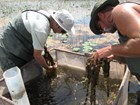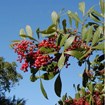Ever wonder when Burmese pythons came to the Everglades, or how they got here? Did you know that bugs can help slow the spread of exotic plants? Do you know what to do if you see an invasive species in Florida? Read here to find out the answers to these questions, and more
-
Everglades National Park
Article 1: Looking for Invasive Species in South Florida

Invasive species are bad news. They are able to spread aggressively outside their natural range, and can cause local extinctions of native species. Invasives are plentiful in South Florida because the subtropical environment allows for many non-native species to thrive, and Miami acts as a port of entry. Local ornamental and pet industries breed animals and plants here that have the potential to escape and survive. Read more
-
Everglades National Park
Article 2: When Plants Go Rogue: Aggressive Exotic Plants Endanger the Everglades

South Florida is a plant paradise, and many non-native plants are able to thrive here. These exotic plants outcompete native plants, and some, like Melaleuca, threaten our water supply by disrupting historical water flow. Then, why do pythons get so much media attention when invasive plants are as great of a threat, if not more, to the Everglades and our own livelihood? Read more
-
Everglades National Park
Article 3: The Race to Keep Invasive Tegus Out of Everglades National Park

Tracking tegus is critical work. Scientists at the National Park Service, the Florida Fish and Wildlife Conservation Commission, the University of Florida, and the U.S. Geological Survey are monitoring the tegus in South Florida because of the potential impact they can have on the environment. Read more
-
Everglades National Park
Article 4: The First Recorded Python in Everglades National Park, 40 Years Later

Everglades National Park just had a 40th anniversary on October 24. It’s one anniversary we’d rather not celebrate. That’s the day in 1979 when the first recorded python was caught in the park near Everglades Safari Park on Tamiami Trail. Read more
-
Everglades National Park
Article 5: So What’s in a Burmese Python Anyway?

Dr. Christina Romagosa is a research associate professor in the University of Florida’s Department of Wildlife Ecology and Conservation in Gainesville, Florida, but much of her work is in South Florida. Her research focuses on how ecosystems respond to invasive species, or non-native species that do harm to the ecosystem. Read more
